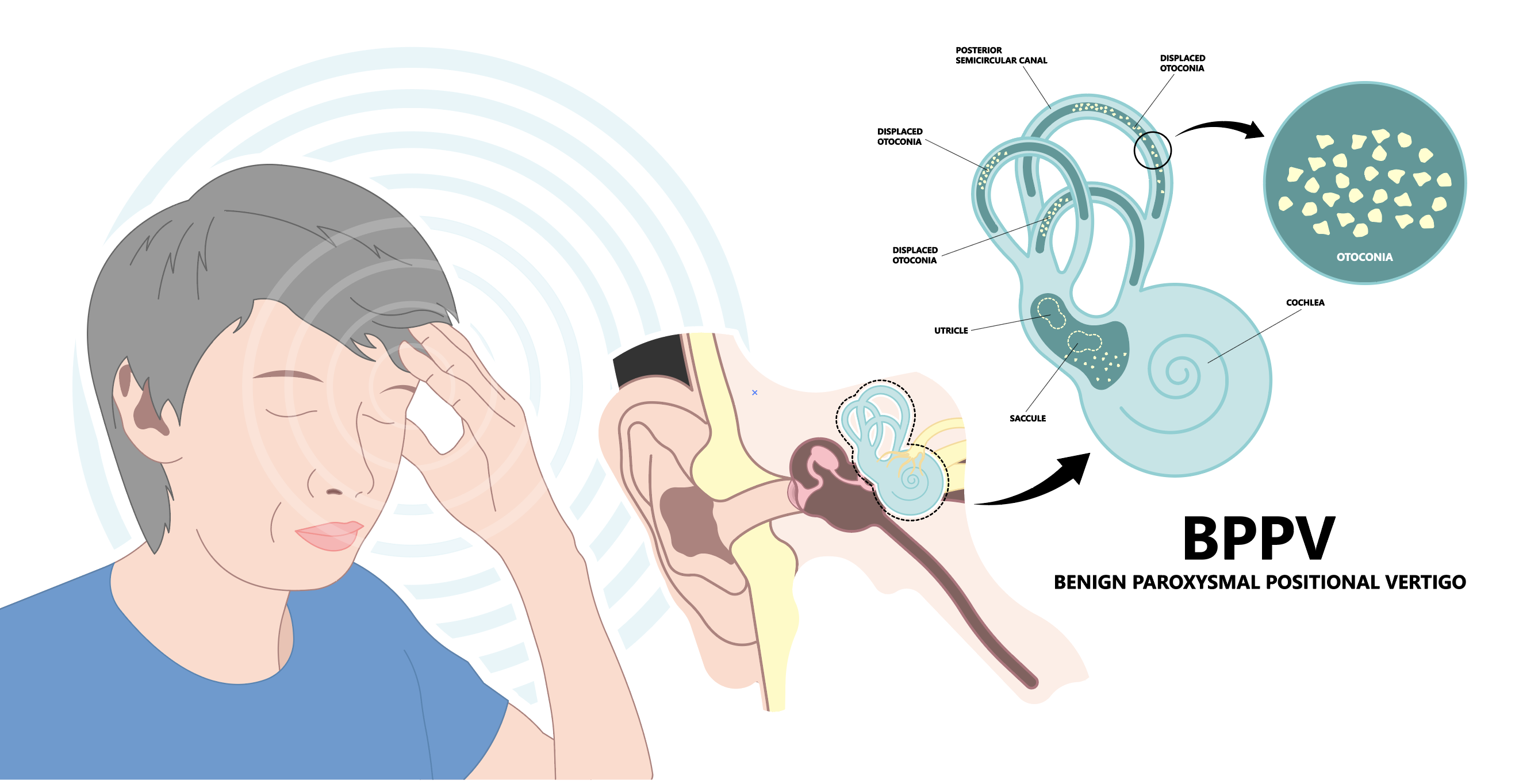What is Benign Paroxysmal Positional Vertigo ?
“Dizziness or Vertigo” is a false sensation of ourselves or our surroundings spinning while being still. This feeling is often described as spinning, whirling, or swaying without actual movement. Benign Paroxysmal Positional Vertigo (BPPV) is one of the common causes when the inner ear’s tiny calcium carbonate crystals called otoconia, which are responsible for movement balancing, moved from their normal positions in the inner ears.
Dr. Pathra Chaiyanam, our otolaryngologist (ear, nose, and throat doctor) at Bangkok Hospital Hua Hin, explains that specific symptom of BPPV is a brief episode of vertigo, which can lead to severe nausea and vomiting. This symptom typically occurs during daily activities, such as getting out of bed, rolling over, or repositioning the head upward or downward.
 Examination and treatment of BPPV
BPPV is diagnosed through a physical examination and special exam called Dix-Hallpike maneuver. During this test, the patient lies on the back, the head is turned to one side and the head hangs slightly off the bed’s edge. If eyeballs spin with vertigo, it confirms this condition.
BPPV is treated with physical therapy by specialist to reposition the inner ear crystals. Most patients recover after the first treatment, but some may require multiple sessions if the symptoms persist.
Examination and treatment of BPPV
BPPV is diagnosed through a physical examination and special exam called Dix-Hallpike maneuver. During this test, the patient lies on the back, the head is turned to one side and the head hangs slightly off the bed’s edge. If eyeballs spin with vertigo, it confirms this condition.
BPPV is treated with physical therapy by specialist to reposition the inner ear crystals. Most patients recover after the first treatment, but some may require multiple sessions if the symptoms persist.
 In terms of medication, there are no specific drugs for BPPV. However, medications may be prescribed to relieve dizziness and nausea. For persistent vertigo, behavioral modifications are recommended. Patients can use an extra pillow to elevate their upper body, avoid quick head movements, and be cautious when changing positions. Looking upward when getting out of bed may reduce the chance of triggering dizziness. After successful treatment, patients can resume a normal life without restricting their movements or sleeping positions.
How do we know that the BPPV is gone?
The vertigo and the severe nausea and vomiting will dramatically improve when the inner crystals gradually return to their positions. After the treatment, the patient may still feel dizzy but it will improve within 2 – 3 days or up to 2 – 3 weeks in some cases. You should revisit the specialist if the symptoms of BPPV do not show improvement.
In terms of medication, there are no specific drugs for BPPV. However, medications may be prescribed to relieve dizziness and nausea. For persistent vertigo, behavioral modifications are recommended. Patients can use an extra pillow to elevate their upper body, avoid quick head movements, and be cautious when changing positions. Looking upward when getting out of bed may reduce the chance of triggering dizziness. After successful treatment, patients can resume a normal life without restricting their movements or sleeping positions.
How do we know that the BPPV is gone?
The vertigo and the severe nausea and vomiting will dramatically improve when the inner crystals gradually return to their positions. After the treatment, the patient may still feel dizzy but it will improve within 2 – 3 days or up to 2 – 3 weeks in some cases. You should revisit the specialist if the symptoms of BPPV do not show improvement.
 Can BPPV get better without the treatment?
Some patients do get better within a week without any medical treatment. Although BPPV can heal on its own, it can be a risk leading to falls, especially among the elderly or individuals with pre-existing balance problems.
Even though the condition has resolved, the recurrence of symptoms may occur. Some accidents, the presence of other inner ear diseases, pre-existing conditions, and aging may be the factors. While the prevention of recurrent BPPV has not yet been discovered, the condition can still be treated.
Can BPPV get better without the treatment?
Some patients do get better within a week without any medical treatment. Although BPPV can heal on its own, it can be a risk leading to falls, especially among the elderly or individuals with pre-existing balance problems.
Even though the condition has resolved, the recurrence of symptoms may occur. Some accidents, the presence of other inner ear diseases, pre-existing conditions, and aging may be the factors. While the prevention of recurrent BPPV has not yet been discovered, the condition can still be treated.
 “Benign Paroxysmal Positional Vertigo (BPPV) is caused by inner ears’ calcium crystals becoming dislodged. It can cause discomfort, including the sensation of spinning or loss of balance and may make the patient hesitant to engage in activities. However, with an understanding of this condition’s nature and appropriate treatment, a normal life can be regained. If you or someone you know experiences sudden and severe dizziness, please consult a specialist for proper treatment and medication.” Dr. Pathra concluded.
**************************************************************************
For more information and booking an appointment, please contact :
Tel. 032-616-800 Call Center, Bangkok Hospital Hua Hin
Tel. 032-616-880 Out-Patient Department (8.00 – 17.00 hrs.)
News & Promotion >> Line ID : @bangkokhuahin
“Benign Paroxysmal Positional Vertigo (BPPV) is caused by inner ears’ calcium crystals becoming dislodged. It can cause discomfort, including the sensation of spinning or loss of balance and may make the patient hesitant to engage in activities. However, with an understanding of this condition’s nature and appropriate treatment, a normal life can be regained. If you or someone you know experiences sudden and severe dizziness, please consult a specialist for proper treatment and medication.” Dr. Pathra concluded.
**************************************************************************
For more information and booking an appointment, please contact :
Tel. 032-616-800 Call Center, Bangkok Hospital Hua Hin
Tel. 032-616-880 Out-Patient Department (8.00 – 17.00 hrs.)
News & Promotion >> Line ID : @bangkokhuahin
 Examination and treatment of BPPV
BPPV is diagnosed through a physical examination and special exam called Dix-Hallpike maneuver. During this test, the patient lies on the back, the head is turned to one side and the head hangs slightly off the bed’s edge. If eyeballs spin with vertigo, it confirms this condition.
BPPV is treated with physical therapy by specialist to reposition the inner ear crystals. Most patients recover after the first treatment, but some may require multiple sessions if the symptoms persist.
Examination and treatment of BPPV
BPPV is diagnosed through a physical examination and special exam called Dix-Hallpike maneuver. During this test, the patient lies on the back, the head is turned to one side and the head hangs slightly off the bed’s edge. If eyeballs spin with vertigo, it confirms this condition.
BPPV is treated with physical therapy by specialist to reposition the inner ear crystals. Most patients recover after the first treatment, but some may require multiple sessions if the symptoms persist.
 In terms of medication, there are no specific drugs for BPPV. However, medications may be prescribed to relieve dizziness and nausea. For persistent vertigo, behavioral modifications are recommended. Patients can use an extra pillow to elevate their upper body, avoid quick head movements, and be cautious when changing positions. Looking upward when getting out of bed may reduce the chance of triggering dizziness. After successful treatment, patients can resume a normal life without restricting their movements or sleeping positions.
How do we know that the BPPV is gone?
The vertigo and the severe nausea and vomiting will dramatically improve when the inner crystals gradually return to their positions. After the treatment, the patient may still feel dizzy but it will improve within 2 – 3 days or up to 2 – 3 weeks in some cases. You should revisit the specialist if the symptoms of BPPV do not show improvement.
In terms of medication, there are no specific drugs for BPPV. However, medications may be prescribed to relieve dizziness and nausea. For persistent vertigo, behavioral modifications are recommended. Patients can use an extra pillow to elevate their upper body, avoid quick head movements, and be cautious when changing positions. Looking upward when getting out of bed may reduce the chance of triggering dizziness. After successful treatment, patients can resume a normal life without restricting their movements or sleeping positions.
How do we know that the BPPV is gone?
The vertigo and the severe nausea and vomiting will dramatically improve when the inner crystals gradually return to their positions. After the treatment, the patient may still feel dizzy but it will improve within 2 – 3 days or up to 2 – 3 weeks in some cases. You should revisit the specialist if the symptoms of BPPV do not show improvement.
 Can BPPV get better without the treatment?
Some patients do get better within a week without any medical treatment. Although BPPV can heal on its own, it can be a risk leading to falls, especially among the elderly or individuals with pre-existing balance problems.
Even though the condition has resolved, the recurrence of symptoms may occur. Some accidents, the presence of other inner ear diseases, pre-existing conditions, and aging may be the factors. While the prevention of recurrent BPPV has not yet been discovered, the condition can still be treated.
Can BPPV get better without the treatment?
Some patients do get better within a week without any medical treatment. Although BPPV can heal on its own, it can be a risk leading to falls, especially among the elderly or individuals with pre-existing balance problems.
Even though the condition has resolved, the recurrence of symptoms may occur. Some accidents, the presence of other inner ear diseases, pre-existing conditions, and aging may be the factors. While the prevention of recurrent BPPV has not yet been discovered, the condition can still be treated.
 “Benign Paroxysmal Positional Vertigo (BPPV) is caused by inner ears’ calcium crystals becoming dislodged. It can cause discomfort, including the sensation of spinning or loss of balance and may make the patient hesitant to engage in activities. However, with an understanding of this condition’s nature and appropriate treatment, a normal life can be regained. If you or someone you know experiences sudden and severe dizziness, please consult a specialist for proper treatment and medication.” Dr. Pathra concluded.
**************************************************************************
For more information and booking an appointment, please contact :
Tel. 032-616-800 Call Center, Bangkok Hospital Hua Hin
Tel. 032-616-880 Out-Patient Department (8.00 – 17.00 hrs.)
News & Promotion >> Line ID : @bangkokhuahin
“Benign Paroxysmal Positional Vertigo (BPPV) is caused by inner ears’ calcium crystals becoming dislodged. It can cause discomfort, including the sensation of spinning or loss of balance and may make the patient hesitant to engage in activities. However, with an understanding of this condition’s nature and appropriate treatment, a normal life can be regained. If you or someone you know experiences sudden and severe dizziness, please consult a specialist for proper treatment and medication.” Dr. Pathra concluded.
**************************************************************************
For more information and booking an appointment, please contact :
Tel. 032-616-800 Call Center, Bangkok Hospital Hua Hin
Tel. 032-616-880 Out-Patient Department (8.00 – 17.00 hrs.)
News & Promotion >> Line ID : @bangkokhuahin